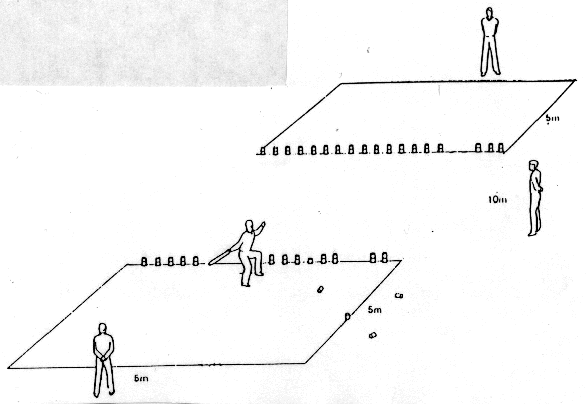KARELIAN SKITTLES - KYYKKÄ
Kyykkä (karelian skittles) is an old folk game from Karelia. Karelian people both from White sea cost and from area around Ladoga lake played this game centuries ago. After the Civil war in Karelia refugees escaped to Finland and brought this game there. It became very popular in Finland
and many kyykkä tournaments are hold every year. There is an International Federation of Gorodki Sport (IFGS) that organizes World Championship in three types of skittles: kyykkä (karelian skittles), gorodki (russian skittles) and eurogorodki.
EVENTS
24th-26th October in Vedlozero was held the Karelian Cup of kyykkä. 9 teams from the regions of Karelia took part in this tournament, among them are experienced players from Kalevala, Petrozavodsk, Vedlozero, Essoila.
Results of this tournament: 1st place - Kičut (Kalevala), 2nd place - Vieljärvi (Vedlozero), 3rd place - ILVES (Petrozavodsk)
13th September in Vilga (Karelia) was held a tournament of kyykkä on the festival "Indian summer". In the final played teams Vieljärvi (Vedlozero) and Ilves (Petrozavodsk). Score in the match was 26.5 - 25 (by reverse system*).
* -
Reverse system will remain only for the games played on folk festivals! Beginning with 1.01.2015 will be used general system for points counting, a team that has more points will be the winner according to the rules of Gorodki International Federation.
RULES OF THE GAME
PLAYING FIELD
Outdoor skittles is played on a gravel surface which should be as even as possible. The playing field, including fringes, measures about 7 x 22 m. The field is composed of two playing squares and an area dividing the field into two. The home team's throwing square is the playing square of the opponent. The playing square measures 5 x 5 m and the area between the squares is 10 m. Playing squares for children under 10 years measure 3 x 3 m and the area between the squares is 6 m.
SKITTLES
The skittles are wooden cylinders rounded at the corners, with a height of 100 mm and a diameter of 65-80 mm. At the beginning of the game, pairs of skittles are placed on the front line of the playing square. In team games, 20 pairs of skittles are placed at intervals, with 10-cm margins. In individual games, 10 pairs of skittles are similarly placed, with 125- cm margins. On a small playing field, the distance from the side line is 25 cm.
BATS
The bats are made of wood, rounded and equipped with handles. The maximum length of the bat is 850 mm and its maximum thickness is 80 mm. There are no limitations for its weight.
THROWING DISTANCES
Boys and girls under 8 years make their opening and continuing throws in the playing square from a 4-m distance (field 3 x 3 m, intermediate area 6 m). Boys and girls under 10 years make their opening throw from 6 m and continue throwing from 4 m. Boys and girls under 12 years make their opening throw from 8 m (field 5 x 5 m, intermediate area 10 m) and continue throwing from 6 m. Boys and girls under 15 years make their opening throw from 10 m and continue throwing from 8 m.
Women make their opening throw in the playing square from a 10-m distance and continue throwing from 8 m. Veteran women over 70 years make their opening and continuing throws from 8 m.
Men make their opening throw in the playing square from a 15-m distance and continue throwing from 10 m. Veteran men over 70 years make their opening and continuing throws from 10 m. In team and pair games, 70-year-olds may open the play from the sides only when the other team members have not been able to knock any skittles out of the playing square.
PROGRESS OF THE GAME
Skittles can be played with four-man teams, in pairs or as an individual game. In team and pair games, the players have two bats at their disposal. In individual games, four bats can be used per turn.
Each player in his turn steps up to the throwing square and by throwing the bat tries to knock the skittles out of the playing square. Skittles thrown out or unused bats yield points; skittles remaining in the playing square or between the playing squares yield minus points.
Skittles remaining in the playing square (crones) yield two minus points; skittles remaining on the lines (priests) yield one minus point, and unused bats yield one point.
The first half ends when either team or pair clears its playing square from skittles. The opponent may throw the same number of bats per half. After this, sides are changed, and the second half is played like the first one. The team with the highest total score is the winner. The winner is awarded two points for the victory. When the play ends in a tie, both teams receive one point. A defeat gives 0 points.
In individual games, 20 bats per half may be used. The first player throws four bats, whereafter the turn goes to the opponent, and after four bats, back again. The result of the player equals the number of unused bats (1 point per bat). When there are no skittles on the field, sides are changed and the second half is played like the first one. The final score of the player is the total result of both halves.
http://www.kyykkaliitto.fi/saannot.php


